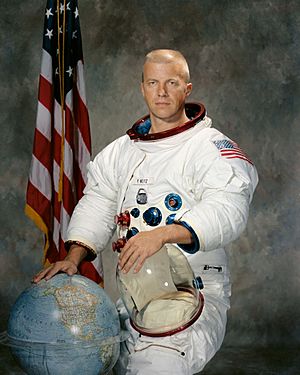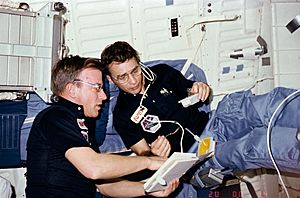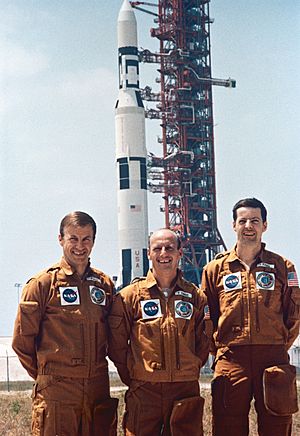Paul J. Weitz facts for kids
Quick facts for kids
Paul J. Weitz
|
|
|---|---|
 |
|
| Born | July 25, 1932 Erie, Pennsylvania, U.S.
|
| Died | October 22, 2017 (aged 85) Flagstaff, Arizona, U.S.
|
| Nationality | American |
| Other names | Paul Joseph Weitz |
| Alma mater | Penn State, B.S. 1954 NPS, M.S. 1964 |
| Occupation | Naval aviator, test pilot |
| Awards | |
| Space career | |
| NASA Astronaut | |
| Rank | |
|
Time in space
|
33d 01h 13m |
| Selection | 1966 NASA Group 5 |
|
Total EVAs
|
1 |
|
Total EVA time
|
1 hour 36 minutes |
| Missions | Skylab 2, STS-6 |
|
Mission insignia
|
 |
| Retirement | May 1994 |
Paul Joseph Weitz (born July 25, 1932 – died October 22, 2017) was an American NASA astronaut. He was also a Navy officer, pilot, and engineer. Paul Weitz flew into space two times. He was part of the first crew to live on Skylab, America's first space station. Later, he commanded the first flight of the Space Shuttle Challenger.
Contents
Life and Career of Paul Weitz
Paul J. Weitz was born in 1932 in Erie, Pennsylvania. He earned a master's degree in engineering. He became a pilot in the Navy before joining NASA. As an astronaut, he traveled to space aboard Skylab and the Space Shuttle. He later worked as a NASA official.
Early Life and Education
Paul Weitz was born in Erie, Pennsylvania, on July 25, 1932. He went to McKinley Elementary School. In 1949, he graduated from Harbor Creek High School. He was the best student in his class, known as the Valedictorian. The high school's sports stadium was later named after him.
In 1954, he earned a Bachelor of Science degree. This was in Aeronautical Engineering from Pennsylvania State University. Ten years later, he received a Master of Science degree. This was also in Aeronautical Engineering from the U.S. Naval Postgraduate School. This school is in Monterey, California.
Flight Experience
Weitz became an Ensign in the Navy through a special program at Penn State. He spent one year at sea on a destroyer ship. After that, he started flight training. He earned his aviator wings in September 1956. He flew many different naval aircraft. In 1966, he was chosen to be an astronaut. He flew for more than 7,700 hours in total. About 6,400 of those hours were in jet aircraft.
NASA Career and Space Missions

In April 1966, Paul Weitz was one of 19 men chosen by NASA. They were part of Astronaut Group 5. He served as the pilot on the Skylab 2 (SL-2) mission. This mission launched on May 25, 1973. It returned to Earth on June 22, 1973.
SL-2 was the first time humans lived on the Skylab space station. The mission lasted for 28 days, which was a record at the time. Weitz and his two crewmates, Pete Conrad and Joseph P. Kerwin, did important repairs. Skylab had been badly damaged during its launch without a crew. Their repairs saved the entire Skylab mission. Weitz spent two hours and 11 minutes outside the spacecraft. This is called an EVA or spacewalk.
In 1976, Weitz left NASA and returned to the Navy. However, he came back to NASA to fly in space again. He was over 50 years old at the time.

Weitz was the commander of the STS-6 mission. This mission launched from Kennedy Space Center, Florida, on April 4, 1983. It was the very first flight of the Space Shuttle Challenger. During the mission, the crew did many experiments. They studied how materials behave in space. They also recorded lightning activities on Earth.
The crew also launched a satellite called TDRS-A. They performed a spacewalk to test new equipment. This helped prepare for future spacewalks. The mission lasted for 120 hours. The Challenger landed at Edwards Air Force Base, California, on April 9, 1983. After this flight, Weitz had spent a total of 793 hours in space.
Paul Weitz retired from NASA in May 1994. At that time, he was the Deputy Director of the Johnson Space Center.
Personal Life and Later Years
Paul Weitz married Suzanne M. Berry. They had two children, Matthew and Cynthia. He enjoyed Hunting and fishing in his free time. After retiring, Weitz lived in Arizona. He passed away on October 22, 2017, at age 85. His death was due to a blood disorder called myelodysplastic syndrome.
Organizations and Memberships
Paul Weitz was a member of these groups:
- Fellow, American Astronautical Society
- Master Mason, Lawrence Lodge 708, Erie, Pennsylvania
Awards and Honors
Paul Weitz received many awards and honors, including:
- Navy Astronaut Wings
- Navy Distinguished Service Medal
- Air Medal (5 times)
- Navy Commendation Medal (for combat flights in Vietnam)
- NASA Distinguished Service Medal
- NASA Space Flight Medal
- Los Angeles Chamber of Commerce Kitty Hawk Award (1973)
- Pennsylvania State University Alumni Association's Distinguished Alumni Award
- Named a Pennsylvania State University Alumni Fellow (1974)
- AIAA Haley Astronautics Award for 1974
- Fédération Aéronautique Internationale's V. M. Komarov Diploma for 1973 (1974)
- 1974 Harmon International Aviation Trophy for Astronaut (1975)
- 1984 Harmon International Award (1989)
The three Skylab astronaut crews received the 1973 Robert J. Collier Trophy. This award recognized their work in showing "the value of man in future explorations of space." Gerald Carr accepted the 1975 Dr. Robert H. Goddard Memorial Trophy from President Ford. This award was also given to the Skylab astronauts. In 1997, Paul Weitz was inducted into the U.S. Astronaut Hall of Fame. He was one of 24 Apollo astronauts to receive this honor.
See also
 In Spanish: Paul J. Weitz para niños
In Spanish: Paul J. Weitz para niños


